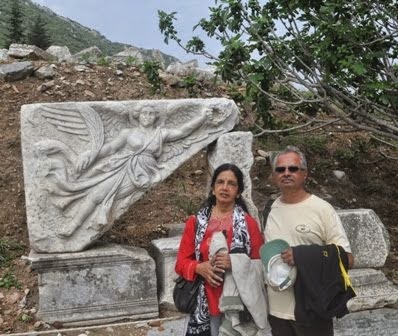Here
the language of stone surpasses the language of man”,
says Rabindranath
Tagore, about the iconic Sun Temple at Konark.
Konarak is our next
destination in our trip to Odisha.
A UNESCO World
Heritage Site, Konark Sun temple is a striking model of ancient artistry and
fluidity of ideas. Dedicated to the sun god, Surya, the first rays of the sun
fall on the entrance of the temple. Much of the temple has fallen into ruin but
what remains still holds enough charm to captivate. Konark temple was initially built on the sea bank but now the sea
has receded and the temple is a little away from the beach. This temple was
also known as 'BLACK PAGODA' due to its
dark color and used as a navigational landmark by ancient sailors to Odisha
The Konark temple is widely known
not only for its architectural greatness but also for the sophistication
and abundance of sculptural work. Konark is an exceptional mixture of marvelous
temple architecture, heritage, exotic beach, and salient natural beauty. The
large structure of Konark Temple seen today is actually the entrance of the
main temple. This has the appearance of a 30 m high chariot with immense wheels
and horses all carved from stone. Since the ruler used to worship the Sun, the
temple was considered as a chariot for the Sun God. Konark Temple was designed
in the form of a gorgeously decorated chariot mounted on 24 wheels, each about
3 M in diameter, and drawn by 7 mighty
horses. The entrance is guarded
by two huge lions, each killing a war elephant and beneath the elephant is a
man. The lions represent pride, elephants represent wealth and both of them
consume a man.
The main temple which enshrined the
presiding deity has fallen off and only the remains can be seen. Even in its
ruined state, it is a magnificent temple reflecting the mastermind of the
architects that imagined and constructed it. It was about 61 m high. A heavy magnet was placed at the temple top and
every two stones of the temple are sandwiched by iron plates. The idol was said
to have been floating in the air due to the arrangement of magnets. The magnet at
the top is said to have disturbed compasses for coastal voyagers and later on
removed.
The structures and elements that have survived are famed for
their intricate artwork, iconography, and themes, including erotic kama and
mithuna scenes. It is a classic illustration of the Odisha style of
Architecture or Kalinga Architecture.
Sun
Temple was built in the 13th-century in dedication to the Hindu Sun Lord –
Surya, by King Narasingha Deva I of the Eastern Ganga Dynasty. Another theory
says that Krishna ‘s son Samba was suffering from leprosy. He stayed in Puri,
took a bath in the sea and watched the sunrise every day and prayed to Sun God for
12 years. He was cured of the disease. In gratitude, Samba had the temple
constructed.
Timings:
Open from 8 am to 6 pm
Entrance
fee: Rs. 3o for Indians and Rs.250 for foreigner
Light
and Sound show at 7 pm: Rs.30
Festival: Chandrabhaga Mela
: February
Konarak Dance Festival:
December 1st week
Photography allowed.
Approved tourist guides are available on payment.
Chandrabhaga beach is about 3 kms away.
A few restaurants are available nearby.
A few resorts and good hotels also exist for those who would
like to stay overnight



















No comments:
Post a Comment